Part of a series of articles titled Park Air Profiles.
Article
Park Air Profiles - Voyageurs National Park
Air Quality at Voyageurs National Park
Most visitors expect clean air and clear views in parks. Given its remote location on the northern edge of Minnesota’s border with Canada, Voyageurs National Park (NP) experiences relatively good air quality. However, the park lies downwind of pollution from sources in the Midwest and Canada, as well as nearby industrial sources like paper mills. Air pollutants blown into the park can harm natural and scenic resources such as soils, surface waters, plants, wildlife, and visibility. The National Park Service works to address air pollution effects at Voyageurs NP, and in parks across the U.S., through science, policy and planning, and by doing our part.
Nitrogen and Sulfur
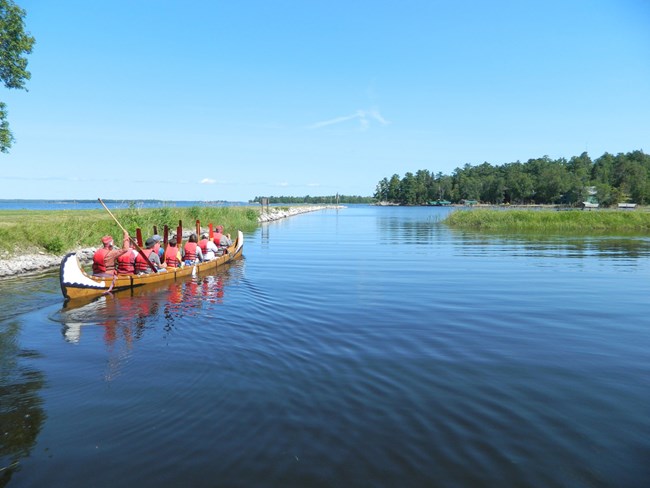
Nitrogen (N) and sulfur (S) compounds deposited from the air may have harmful effects on ecosystem processes. Healthy ecosystems can naturally buffer a certain amount of pollution, but once a threshold is passed the ecosystem may respond negatively. This threshold is the critical load, or the amount of pollution above which harmful changes in sensitive ecosystems occur (Porter 2005). N and S deposition change ecosystems through eutrophication (N deposition) and acidification (N + S deposition). Eutrophication increases soil and water nutrients which causes some species to grow more quickly and changes community composition. Ecosystem sensitivity to nutrient N enrichment at Voyageurs National Park (VOYA) relative to other national parks is low (Sullivan et al. 2016); for a full list of N sensitive ecosystem components, see: NPS ARD 2019. Acidification leaches important cations from soils, lakes, ponds, and streams which decreases habitat quality. Ecosystem sensitivity to acidification at VOYA relative to other national parks is very high (Sullivan et al. 2016); to search for acid-sensitive plant species, see: NPSpecies.
From 2017-2019 total N deposition in VOYA ranged from 4.5 to 5.5 kg-N ha-1 yr-1 and total S deposition ranged from 1.0 to 1.3 kg-S ha-1 yr-1 based on the TDep model (NADP, 2018). VOYA has been monitoring atmospheric N and S deposition since 2000, see the conditions and trends website for park-specific information.
In boreal lakes, increased N can affect biodiversity, algal communities, and water clarity (Sullivan et al. 2016; Kallemeyn et al. 2003; Wiener et al. 2006; Swackhamer and Hornbuckle 2004).
VOYA’s thin, undeveloped soils, underlying granitic rock, and low buffering capacity result in surface waterways and soils at high risk from acidification by atmospheric N and S (Sullivan et al. 2016). S is a concern at VOYA because it plays an essential role in the methylation of mercury, leading to toxic accumulation of methylmercury in fish and wildlife. Also, S is a strong driver of acidification in the VOYA’s vulnerable lakes and streams.
Epiphytic macrolichen community responses
Epiphytic macrolichens grow on tree trunks, branches, and boles. Since these lichens grow above the ground, they obtain all their nutrients directly from precipitation and the air. Many epiphytic lichen species have narrow environmental niches and are extremely sensitive to changes in air pollution. Geiser et al. (2019) used a U.S. Forest Service national survey to develop critical loads of nitrogen (N) and critical loads of sulfur (S) to prevent more than a 20% decline in four lichen community metrics: total species richness, pollution sensitive species richness, forage lichen abundance, and cyanolichen abundance.
McCoy et al. (2021) used forested area from the National Land Cover Database to estimate the impact of air pollution on epiphytic lichen communities. Forested area makes up 368 km2 (44.4%) of the land area of Voyageurs National Park.
- N deposition exceeded the 3.1 kg-N ha-1 yr-1 critical load to protect N-sensitive lichen species richness in 100% of the forested area.
- S deposition was below the 2.7 kg-S ha-1 yr-1 critical load to protect S-sensitive lichen species richness in every part of the forested area.
For exceedances of other lichen metrics and the predicted decline of lichen communities see Appendices A and B of McCoy et al. (2021).
Additional modeling was done on 459 lichen species to test the combined effects of air pollution and climate gradients (Geiser et al. 2021). A critical load indicative of initial shifts from pollution-sensitive toward pollution-tolerant species occurred at 1.5 kg-N ha-1 yr-1 and 2.7 kg-S ha-1 yr-1 even under changing climate regimes.
Plant species response
Plants vary in their tolerance of eutrophication and acidification, and some plant species respond to nitrogen (N) or sulfur (S) pollution with declines in growth, survival, or abundance on the landscape. Horn et al. (2018) used the U.S. Forest Service national forest survey to develop critical loads of N and critical loads of S to prevent declines in growth or survival of sensitive tree species. Clark et al. (2019) used a database of plant community surveys to develop critical loads of N and critical loads of S to prevent a decline in abundance of sensitive herbaceous plant species. According to NPSpecies, Voyageurs National Park contains:
- 14 N-sensitive tree species and 79 N-sensitive herbaceous species.
- 23 S-sensitive tree species and 65 S-sensitive herbaceous species.
Mycorrhizal fungi community response
Many plants have a symbiotic relationship with mycorrhizal fungi (MF). Through the roots, the plants supply the fungi with carbon from photosynthesis and in exchange the MF enhance nutrient availability within soils, increase drought tolerance, and provide physical resistance to soil erosion (George et al., 1995; Cheng et al., 2021; Burri et al., 2013). Anthropogenic Nitrogen (N) deposition can disrupt this symbiotic relationship resulting in a shift from N sensitive to N tolerant mycorrhizal fungi and plant communities.
With increased N deposition to the soil, MF become less important for nutrient uptake and many plants will cease the exchange of nutrients altogether making them more vulnerable to stressors such as drought (Lilleskov et al., 2019). The CL-N for the shift in mycorrhizal community is 5-6 kg-N ha-1 yr-1 in coniferous forests and 10-20 kg-N ha-1 yr-1 broadleaf forests.
Voyageurs National Park has 76.8 km2 of coniferous forests, 63.2 km2 of broadleaf forests, and 404.6 km2 of mixed forests. Using the range in critical loads above, the minimum CL is exceeded in 74.3% of forested area and the maximum CL is exceeded in 0% of forested area based on 2019-2021 TDep Total N deposition.
Change in N and S deposition from 2000 to 2021
The maps below show how the spatial distribution of estimated Total N and Total S deposition in VOYA has changed from 2000-2002 to 2019-2021 (TDep MMF version 2022.02). Slide the arrows in the middle of the image up and down to compare N and S deposition between the two years (Yearly Data).
- Minimum N deposition decreased from 4.9 to 3.2 kg-N ha-1 yr-1 and maximum N deposition decreased from 7.9 to 6.3 kg-N ha-1 yr-1.
- Minimum S deposition decreased from 2.4 to 0.7 kg-S ha-1 yr-1 and maximum S deposition decreased from 2.9 to 0.9 kg-S ha-1 yr-1.
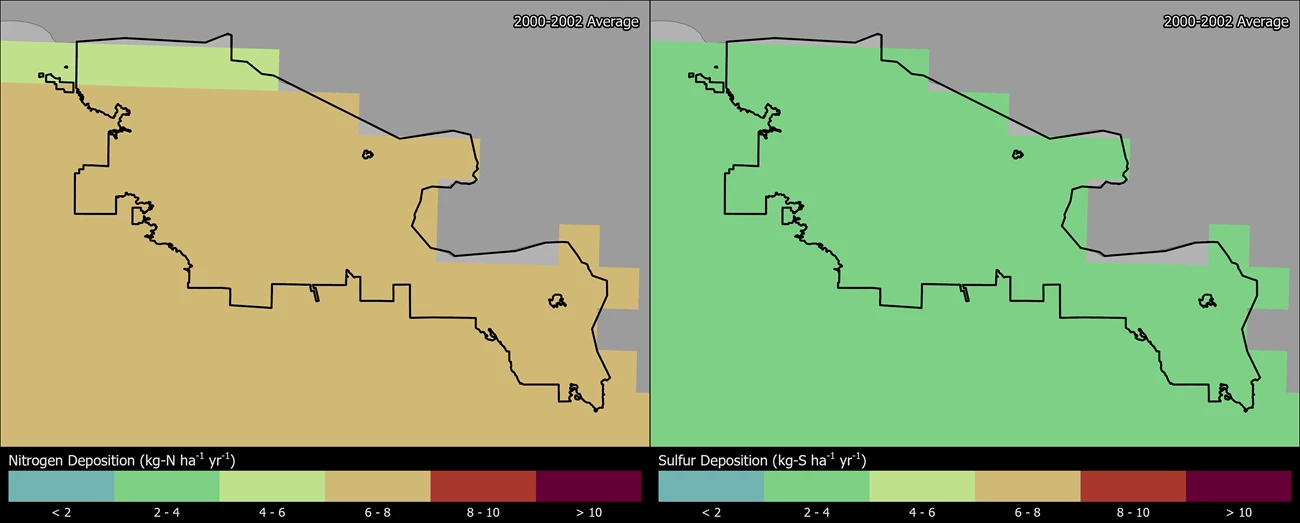
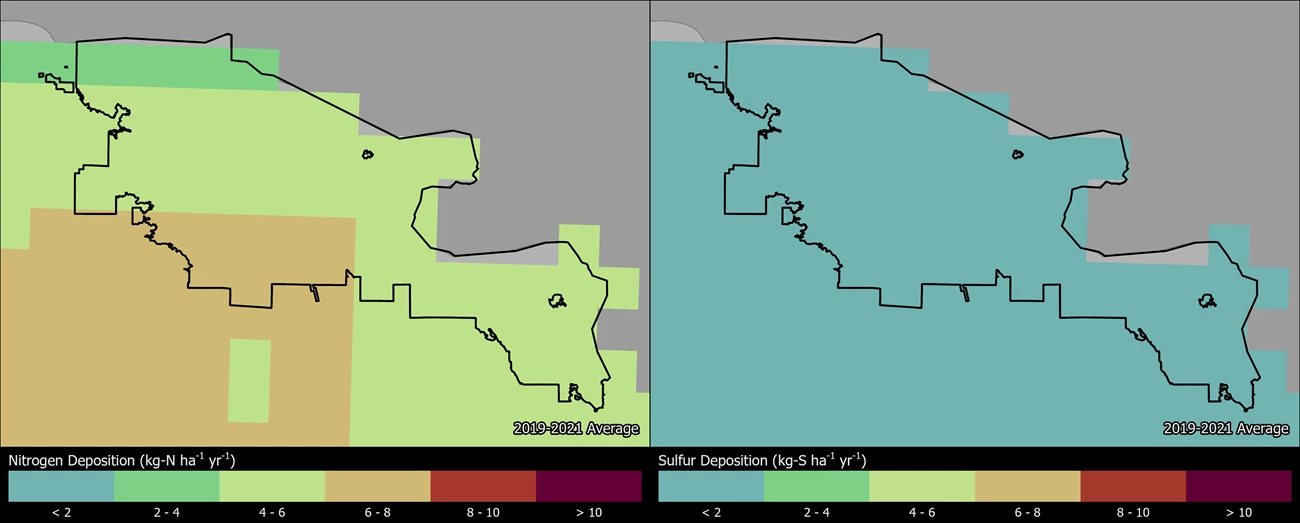
Persistent Pollutants
Pollutants like mercury and pesticides are concerning because they are persistent and toxic in the environment. These contaminants can travel in the air thousands of miles away from the source of pollution, even depositing in protected places like national parks. In addition, while some of these harmful pollutants may be banned from use, historically contaminated sites continue to endure negative environmental consequences.
When deposited, airborne mercury and other toxic air contaminants are known to harm wildlife like birds and fish, and cause human health concerns. Many of these substances enter the food chain and accumulate in the tissue of organisms causing reduced reproductive success, impaired growth and development, and decreased survival.While Voyageurs NP is in a remote location on the Minnesota-Canada border, nearby and distant sources contribute to the deposition of toxics at the park, including mercury. Voyageurs NP is particularly sensitive to mercury pollution. The abundance of wetlands, low pH lakes, complex food webs, and predatory fish create an environment susceptible to the bioaccumulation of toxics.
- Mercury concentrations in some fish sampled at Voyageurs NP exceeded the threshold for human consumption. Preliminary data from three sites in the park indicate an average fish mercury concentration of 0.311 ppm ww. Mercury concentrations in 30% of fish sampled (n=60) exceeded the US EPA threshold established for human consumption (0.3 ppm ww) (Eagles-Smith et al. 2019). However, the data may not reflect the risk at other unsampled locations in the park. Fish consumption advisories may be in effect for mercury and other contaminants (NPS 2022).
- Some dragonfly larvae sampled at Voyageurs NP had mercury concentrations at a moderate impairment level. Dragonfly larvae have been sampled and analyzed for mercury from four sites in the park; 89% of the data fall into the moderate (100-300 ng/g dw) impairment category for potential mercury risk. An index of moderate impairment or higher suggests some fish may exceed the US EPA benchmark for protection of human health (Eagles-Smith et al. 2018; Eagles-Smith et al. 2020). Haro et al. 2013 similarly detected mercury in dragonfly larvae from the park, and identified a positive correlation with mercury concentrations in fish.
- Mercury and other contaminants have been found in park samples of bird feathers, eggs, and blood (Scheuhammer and Blancher 1994; Evers et al. 1998; Pittman 2010; Evers et al. 2011a; Pittman et al. 2011;). Average mercury concentration was lower in red-winged blackbird eggs than in tree swallow eggs, presumably reflecting their different trophic positions. Mercury exposure to wetland bird eggs can vary significantly both within nesting season and between years (Tyser et al. 2016).
- Contaminants were also found in park water and vegetation. The two most common contaminants of emerging concern (CECs) found in park surface water were atrazine and DEET with 89% and 56% detection frequencies, respectively (Elliott and VanderMeulen 2018). PFOS, a by-product in the manufacture of fabric protectors, firefighting foams, and other chemicals, was also detected in park water samples (Simcik and Dorweiler 2005). Contaminants were also found in elevated concentrations in tributaries to the Great Lakes (Elliot et al. 2017; Thomas et al. 2017).
- Mercury in wet deposition in the Great Lakes region has been monitored by various long-term studies since the 1990’s (Evers et al. 2011a; Brigham et al. 2014; Weiss-Penzias et al. 2016; Brigham et al. 2021). The data show that declining trends in mercury deposition generally occurred until 2008, after which relatively flat or even positive trends occurred. Elevated levels of mercury were found in rain and snow at monitoring sites near Voyageurs NP (Risch et al. 2012).
- Over three decades of studies continue to show elevated concentrations of many contaminants—specifically mercury and PCBs—in park air, precipitation, water, sediment, fish, loons, and various levels of the food web (Cain et al. 2011; Christensen et al. 2016; Evers et al. 2011a; Evers et al. 2011b; Kallemeyn et al. 2003; NPS 2010; Sandheinrich and Drevnick 2016; Route 2011; Sandheinrich et al. 2011; Scheuhammer and Blancher 1994; Sorensen et al. 2005; Sorensen et al. 2001; Swackhamer and Hornbuckle 2004; Wiener et al. 2022; Wiener et al. 2016; Wiener et al. 2012; Wiener et al. 2006).
The NPS Air Resources Division reports on park conditions and trends for mercury. Visit the webpage to learn more.
Visibility
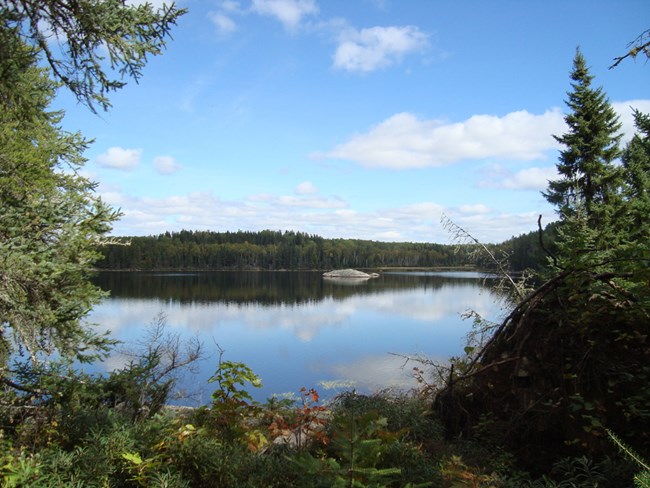
Visitors come to Voyageurs NP to enjoy the spectacular “North Woods”, a wilderness of interconnected waterways, and the northern lights. Park vistas are sometimes obscured by haze, reducing how well and how far people can see. Visibility reducing haze is caused by tiny particles in the air, and these particles can also affect human health. Many of the same pollutants that ultimately fall out as nitrogen and sulfur deposition contribute to this haze. Organic compounds, soot, and dust reduce visibility as well. Smoke from nearby forest fires also contributes to particulate matter in the region. Significant improvements in park visibility have been documented since the 2000’s. Overall, visibility in the park still needs improvement to reach the Clean Air Act goal of no human caused impairment.
Visibility effects:
- Reduced visibility, at times, due to human-caused haze and fine particles of air pollution;
- Reduction of the average natural visual range from about 115 miles (without pollution) to about 100 miles because of pollution at the park;
- Reduction of the visual range to below 50 miles on very hazy days.
Visit the NPS air quality conditions and trends website for park-specific visibility information. Voyageurs NP has been monitoring visibility since 1988. Explore scenic vistas of Lake Superior and other sites in the Great Lakes via live webcams, and explore air monitoring »
Ground-Level Ozone
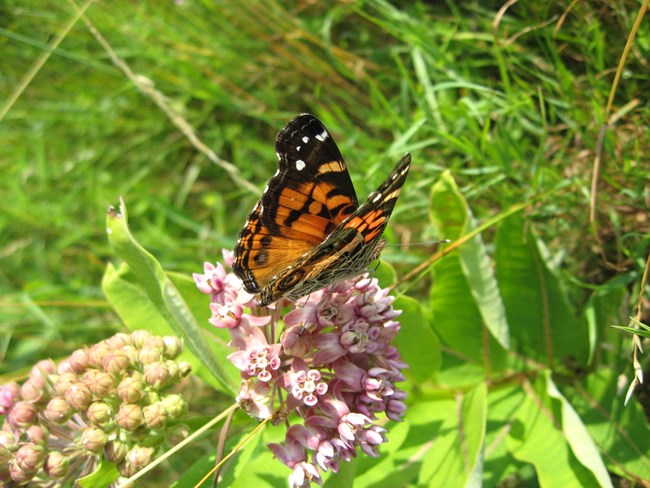
At ground level, ozone is harmful to human health and the environment. Ground-level ozone does not come directly from smokestacks or vehicles, but instead is formed when other pollutants, mainly nitrogen oxides and volatile organic compounds, react in the presence of sunlight.
Over the course of a growing season, ozone can damage plant tissues making it harder for plants to produce and store food. It also weakens plants making them less resistant to disease and insect infestations. Some plants are more sensitive to ozone than others. Ozone-sensitive plants in Voyageurs NP include Apocynum androsaemifolium (Spreading dogbane), Ascelpias syriaca (Common milkweed), and Prunus serotina (Black cherry). A risk assessment that considered ozone exposure, soil moisture, and sensitive plant species concluded that plants in Voyageurs NP were at low risk of damage to plant leaves (see network report: Kohut 2004). Ozone injury to plants has not been documented in regions near Voyageurs NP (Swackhamer and Hornbuckle 2004). Search ozone-sensitive plant species found at Voyageurs NP.
Visit the NPS air quality conditions and trends website for park-specific ozone information. Voyageurs NP has been monitoring ozone since 1987. View live ozone and meteorology data, and explore air monitoring »
Explore Other Park Air Profiles
There are 47 other Park Air Profiles covering parks across the United States and its territories.
References
Bennett, J. P. and Wetmore, C. M. 1997. Chemical element concentrations in four lichens on a transect entering Voyageurs National Park. Environmental and Experimental Botany 37: 259–277.
Brigham ME and Others. 2021. Long-term trends in regional wet mercury deposition and lacustrine mercury concentrations in four lakes in Voyageurs National Park. Applied Sciences. 11(4). https://irma.nps.gov/DataStore/Reference/Profile/2284624
Brigham ME and Others. 2014. Lacustrine Responses to Decreasing Wet Mercury Deposition Rates - Results from a Case Study in Northern Minnesota. Environmental Science & Technology. 48(11):6115-6123. https://irma.nps.gov/DataStore/Reference/Profile/2230277
Burri, K., C. Gromke, and F. Graf. "Mycorrhizal fungi protect the soil from wind erosion: a wind tunnel study." Land Degradation & Development 24.4 (2013): 385-392.
Cain, A., Morgan, J. T., and Brooks, N. 2011. Mercury policy in the Great Lakes states: past successes and future opportunities. Ecotoxicology 20: 1500–1511. https://doi.org/10.1007/s10646-011-0764-4
Cheng, Shen, et al. "Elucidating the mechanisms underlying enhanced drought tolerance in plants mediated by arbuscular mycorrhizal fungi." Frontiers in Microbiology 12 (2021): 809473.
Christensen, V.G., Larson, J.H., Maki, R.P., Sandheinrich, M.B., Brigham, M.E., Kissane, Claire, and LeDuc, J.F., 2017, Lake levels and water quality in comparison to fish mercury body burdens, Voyageurs National Park, Minnesota, 2013–15: U.S. Geological Survey Scientific Investigations Report 2016–5175, 17 p., https://doi.org/10.3133/sir20165175
Clark, C.M., Simkin, S.M., Allen, E.B. et al. Potential vulnerability of 348 herbaceous species to atmospheric deposition of nitrogen and sulfur in the United States. Nat. Plants 5, 697–705 (2019). https://doi.org/10.1038/s41477-019-0442-8
Eagles-Smith, C.A., S.J. Nelson., C.M. Flanagan Pritz, J.J. Willacker Jr., and A. Klemmer. 2018. Total Mercury Concentrations in Dragonfly Larvae from U.S. National Parks (ver. 6.0, June 2021): U.S. Geological Survey data release. https://doi.org/10.5066/P9TK6NPT
Eagles-Smith, CA, JJ Willacker, CM Flanagan Pritz, AC Ellsworth. 2019. Total Mercury Concentrations in Fish from 31 National Parks, USA, 2015-2016. USGS Sensitive Data Release. https://irma.nps.gov/DataStore/Reference/Profile/2260288
Eagles-Smith, C.A., J.J. Willacker, S.J. Nelson, C.M. Flanagan Pritz, D.P. Krabbenhoft, C.Y. Chen, J.T. Ackerman, E.H. Campbell Grant, and D.S. Pilliod. 2020. Dragonflies as biosentinels of mercury availability in aquatic food webs of national parks throughout the United States. Environmental Science and Technology 54(14):8779-8790. https://doi.org/10.1021/acs.est.0c01255
Elliott SM, Brigham ME, Lee KE, Banda JA, Choy SJ, et al. 2017. Contaminants of emerging concern in tributaries to the Laurentian Great Lakes: I. Patterns of occurrence. PLOS ONE 12(9): e0182868. https://doi.org/10.1371/journal.pone.0182868
Elliott, Sarah M. and David D. VanderMeulen. 2017. A regional assessment of chemicals of concern in surface waters of four Midwestern United States national parks. Science of The Total Environment 579:1726-1735. https://doi.org/10.1016/j.scitotenv.2016.11.114
Evers, D. C., Kaplan, J. D., Meyer, M. W., Reaman, P. S., Braselton, W. E., Major, A., and Burgess, N., Scheuhammer, A. M. 1998. Geographic trend in mercury measured in common loon feathers and blood. Environmental Toxicology & Chemistry 17 (2): 173–183. https://irma.nps.gov/DataStore/Reference/Profile/52731
Evers, D. C., Wiener, J. G., Driscoll, C. T., Gay, D. A., Basu, N., Monson, B. A., Lambert, K. F., Morrison, H. A., Morgan, J. T., Williams, K. A., and Soehl, A. G. 2011a. Great Lakes Mercury Connections: The Extent and Effects of Mercury Pollution in the Great Lakes Region. Biodiversity Research Institute. Gorham, Maine. Report BRI 2011—18. 44 pp. Available at http://www.briloon.org/our-science-services/research-centers/center-for-mercury-studies-detail-page/mercury-center-opening-page/center-for-mercury-project-index/mercury-connections-landing-page/mercury-in-the-great-lakes-region.
Evers, D. C., Williams, K. A., Meyer, M. W., Scheuhammer, A. M., Schoch, N., Gilbert, A., Siegel, L., Taylor, R. J., Poppenga, R. and Perkins, C. R. 2011b. Spatial gradients of methylmercury for breeding common loons in the Laurentian Great Lakes region. Ecotoxicology 20: 1609–1625. https://doi.org/10.1007/s10646-011-0753-7
Geiser, Linda & Nelson, Peter & Jovan, Sarah & Root, Heather & Clark, Christopher. (2019). Assessing Ecological Risks from Atmospheric Deposition of Nitrogen and Sulfur to US Forests Using Epiphytic Macrolichens. Diversity. 11. 87. 10.3390/d11060087.
Geiser, Linda & Root, Heather & Smith, Robert & Jovan, Sarah & Clair, Larry & Dillman, Karen. (2021). Lichen-based critical loads for deposition of nitrogen and sulfur in US forests. Environmental Pollution. 291. 118187. 10.1016/j.envpol.2021.118187.
George, Eckhard, Horst Marschner, and Iver Jakobsen. "Role of arbuscular mycorrhizal fungi in uptake of phosphorus and nitrogen from soil." Critical reviews in biotechnology 15.3-4 (1995): 257-270.
Haro RJ and Others. 2013. Burrowing Dragonfly Larvae as Biosentinels of Methylmercury in Freshwater Food Webs. Environmental Science & Technology. 47(15):8148-8156. https://irma.nps.gov/DataStore/Reference/Profile/2230258
Horn KJ, Thomas RQ, Clark CM, Pardo LH, Fenn ME, Lawrence GB, et al. (2018) Growth and survival relationships of 71 tree species with nitrogen and sulfur deposition across the conterminous U.S.. PLoS ONE 13(10): e0205296. https://doi.org/10.1371/journal.pone.0205296
Kallemeyn, L. W., Holmberg, K. L., Perry, J. A., and Odde, B. Y. 2003. Aquatic Synthesis for Voyageurs National Park: U.S. Geological Survey, Information and Technology Report 2003—0001. 95 pp. Available at https://pubs.er.usgs.gov/publication/itr030001
Kohut, R. 2004. Assessing the Risk of Foliar Injury from Ozone on Vegetation in Parks in the Great Lakes Network. Available at https://irma.nps.gov/DataStore/Reference/Profile/2181290.
Lilleskov, Erik A., et al. "Atmospheric nitrogen deposition impacts on the structure and function of forest mycorrhizal communities: a review." Environmental Pollution 246 (2019): 148-162.
McCoy K., M. D. Bell, and E. Felker-Quinn. 2021. Risk to epiphytic lichen communities in NPS units from atmospheric nitrogen and sulfur pollution: Changes in critical load exceedances from 2001‒2016. Natural Resource Report NPS/NRSS/ARD/NRR—2021/2299. National Park Service, Fort Collins, Colorado. https://doi.org/10.36967/nrr-2287254.
[NADP] National Atmospheric Deposition Program. 2018. NTN Data. Accessed January 20, 2022. Available at http://nadp.slh.wisc.edu/NADP/
[NPS] National Park Service. 2010. Monitoring Persistent Contaminants at Voyageurs. Resource Brief, Great Lakes Network.
[NPS] National Park Service. 2022. Fish Consumption Advisories. https://www.nps.gov/subjects/fishing/fish-consumption-advisories.htm
Pittman, H. T. 2010. Using Nestling Bald Eagles to Assess Temporal and Spatial Trends of Environmental Contaminants, Voyageurs National Park, Minnesota. MS Thesis, Clemson University. Available at https://tigerprints.clemson.edu/all_theses/995/.
Pittman, H. T., Bowerman, W. W., Grim, L. H., Grubb, T. G., and Bridges, W. C. 2011. Using nestling feathers to assess spatial and temporal concentrations of mercury in bald eagles at Voyageurs National Park, Minnesota, USA. Ecotoxicology 20: 1626–1635. Available at https://www.ncbi.nlm.nih.gov/pubmed/21779822.
Porter, E., Blett, T., Potter, D.U., Huber, C. 2005. Protecting resources on federal lands: Implications of critical loads for atmospheric deposition of nitrogen and sulfur. BioScience 55(7): 603–612. https://doi.org/10.1641/0006-3568(2005)055[0603:PROFLI]2.0.CO;2
Risch M. R., Gay, D. A., Fowler, K. K., Keeler, G. J., Backus, S. M., Blanchard, P., Barres, J. A., Dvonch, J. T. 2012. Spatial patterns and temporal trends in mercury concentrations, precipitation depths, and mercury wet deposition in the North American Great Lakes region, 2002–2008. Environmental Pollution 161: 261–271. https://doi.org/10.1016/j.envpol.2011.05.030
Route, Bill. 2011. Mercury in National Parks of the Upper Midwest. Resource Brief. https://irma.nps.gov/DataStore/DownloadFile/472552
Sandheinrich, M. B., Bhavsar, S. P., Bodaly, R. A., Drevnick, P. E., Paul, E. A. 2011. Ecological risk of methylmercury to piscivorous fish of the Great Lakes region. Ecotoxicology 20: 1577–1587. https://doi.org/10.1007/s10646-011-0712-3
Scheuhammer, A. M. and Blancher, P. J. 1994. Potential risk to common loons (Gavia immer) from methylmercury exposure in acidified lakes. Hydrobiologia 279/280: 445–455. https://doi.org/10.1007/BF00027876
Simcik, M. F. and Dorweiler, K. J. 2005. Ratio of Perfluorochemical Concentrations as a Tracer of Atmospheric Deposition to Surface Waters. Environmental Science and Technology. 39(22): 8678–8683. https://doi.org/10.1021/es052244v
Sorenson, J. A., Rapp Jr., G., Glass, G. E. 2001. The effect of exotic rainbow smelt (Osmerus mordax) on nutrient/trophic pathways and mercury contaminant uptake in the aquatic food web of Voyageurs National Park, a benchmark study of stable element isotopes. NPS Final Report. 52 pp. https://irma.nps.gov/DataStore/Reference/Profile/569798
Sorensen, J. A., Kallemeyn, L. W., Sydor, M. 2005. Relationship between Mercury Accumulations in Young-of-the-Year Yellow Perch and Water-Level Fluctuations. Environmental Science and Technology. Environmental Science & Technology 39 (23): 9237–9243. https://irma.nps.gov/DataStore/Reference/Profile/609769
Sullivan, T. J. 2016. Air quality related values (AQRVs) in national parks: Effects from ozone; visibility reducing particles; and atmospheric deposition of acids, nutrients and toxics. Natural Resource Report NPS/NRSS/ARD/NRR—2016/1196. National Park Service, Fort Collins, CO.
Swackhamer, D. L. and Hornbuckle, K. C. 2004. Assessment of Air Quality and Air Pollutant Impacts in Isle Royale National Park and Voyageurs National Park. NPS Report. Available at https://irma.nps.gov/DataStore/Reference/Profile/575135
Thomas LM, Jorgenson ZG, Brigham ME, Choy SJ, Moore JN, et al. (2017) Contaminants of emerging concern in tributaries to the Laurentian Great Lakes: II. Biological consequences of exposure. PLOS ONE 12(9): e0184725. https://doi.org/10.1371/journal.pone.0184725
Tyser, R.W., Rolfhus, K.R., Wiener, J.G. et al. 2016. Mercury Concentrations in Eggs of Red-Winged Blackbirds and Tree Swallows Breeding in Voyageurs National Park, Minnesota. Arch Environ Contam Toxicol 71, 16–25. https://irma.nps.gov/DataStore/Reference/Profile/2293401
Wiener JG and Others. 2022. Mercury data of individual fish and individual dragonflies collected in 6 Great Lakes National Park Units, 2008-2012. https://irma.nps.gov/DataStore/Reference/Profile/2293812
Wiener JG and Others. 2016. Bioaccumulative contaminants in aquatic food webs in six national park units of the western Great Lakes region: 2008–2012. Natural Resource Report. NPS/GLKN/NRR—2016/1302. National Park Service. Fort Collins, Colorado. https://irma.nps.gov/DataStore/Reference/Profile/2233537
Wiener, J. G., Evers, D. C., Gay, D. A., Morrison, H. A., and Williams, K. A. 2012. Mercury contamination in the Laurentian Great Lakes region: introduction and overview. Environmental Pollution 161: 243–251. https://doi.org/10.1016/j.envpol.2011.08.051
Wiener, J. G., Knights, B. C., Sandheinrich, M. B., Jeremiason, J. D., Brigham, M. E., Engstrom, D. R., Woodruff, L. G., Cannon, W. F., and Balogh, S. J. 2006. Mercury in soils, lakes, and fish in Voyageurs National Park (Minnesota): Importance of atmospheric deposition and ecosystem factors. Environmental Science & Technology 40 (20): 6261–6268. https://irma.nps.gov/DataStore/Reference/Profile/664132
Weiss-Penzias, Peter S., David A. Gay, Mark E. Brigham, Matthew T. Parsons, Mae S. Gustin, Arnout ter Schure. 2016. Trends in mercury wet deposition and mercury air concentrations across the U.S. and Canada. Science of The Total Environment 568: 546-556. https://doi.org/10.1016/j.scitotenv.2016.01.061
Last updated: August 6, 2024
